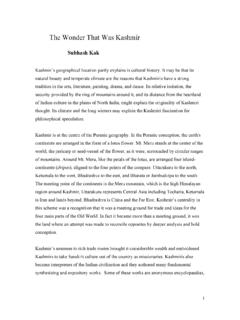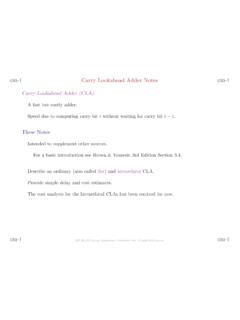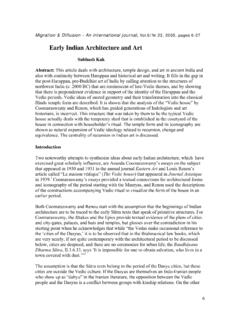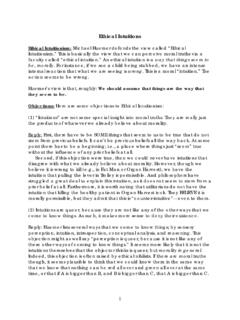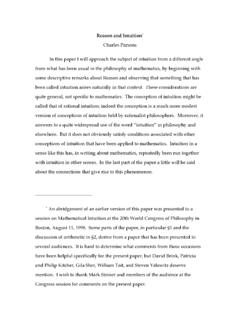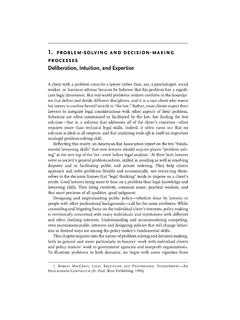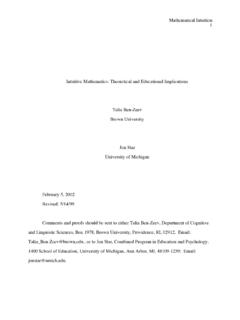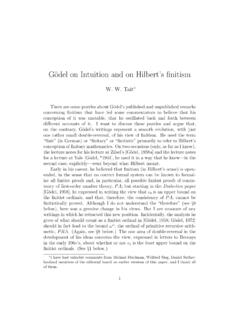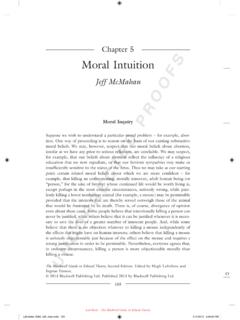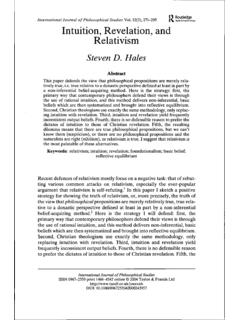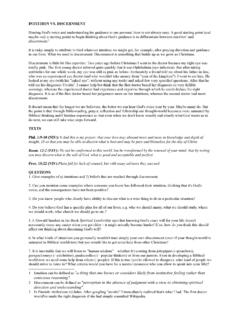Transcription of ThePrajn„~aS„utra: Aphorisms of Intuition
1 ThePraj n a S utra:Aphorismsof IntuitionSubhashKakBatonRouge,2006 ContentsPrefacev1. Introduction12. TheS utras73. Commentary94. TheSelf and Recursion535. Languagesof the Brain616. TheFourthWay697. Afterword74 Index75ivc SubhashKak,2003,2006 PrefaceThisbook is about the cosmologythatunderliescon-sciousness,wri ttenin the style of s considersquestionssuch as freedomin a worldboundby laws,the connectionbetween the particularexperienceand theuniversal,art and its role,sufferingand utrasare presented in theirSanskritoriginal,togetherwithtransl ationand commentary. Thesignifi-canceof theses utrasto questionsof faithandmeaningis ,January24, 2006 SubhashKak1 IntroductionTheses utrascameto me whileI was on a ContinentalAirlinesflight fromWashingtonto Houstonon October13, wrotethemdown very quickly, perhapsin nomorethana few intuitionson the essenceof Vedicwisdom,and theycouldbe usefulin preparingoneselffor the morecomplextextsof I hadgiven a lectureat GeorgeMasonUniversity in Fairfax,Virginiawherethe discus-sion at the end took a was struck byhow our argumentationgot boggeddown in the attemptsto sortout the definingterms,which were understoodvariouslyby different the Westerntradition.
2 Thisdifficulty is mitigatedby the fact thatthe concernsare generallyregardingtheouteraspectsof thingsthatare less is concernedprimarilywiththe expe-riencingself,its questionsof definitionare the reasoninstructionin Indianphilosophyis also given by employingsynthesisthatis basedon it is a commonerrorto take word ( sabda) in itsliteral, surfacesenseas truecognition(pram ). Muchof contemporaryacademicscholarshiphas failedto sortthroughthe different layers of the Vedic narrative by con-flatingthe symbolic withthe s utrastie togethersomecommonsymbols usedinthe Indiantraditionto theirdeeper some-2 SubhashKakone whohasn tthe timeor the inclinationto readthediversetextsof the Vedictradition,theycouldserve asan is sabda as literalword problematic?
3 Accordingto the tradition(as in the ),languagecan onlycommunicatelower formof knowledgeand truecognitionis point of viewoflanguagetheory, the meaningof wordsis not determinedobjectively, for it must be fixedby contextand proper definitionof words,a statement may be interpretedin different ways. Mod-ern studiesconfirmthe limitationsof languageand suchlimitationsextendto literal sabda as pram , we see commen-tatorsparsethe greatdeclarations(mah av akyas) sabdamay be interpretedas implyingoverlordship( svarav ada)by one groupandreductionism(nir svarav ada)by an-other!Such enormousdifferencein meaningcan leadtoequallydifferent approaches to questionof ontology, mostpeopleareinterestedin understandingthemselves. Thereare ques-tionslike: Do we have a trueself?
4 Accordingto the tra-dition,this self is the perceiving I whois independentof locationand personalhistory, and this self is a how does one separatethis coreof one sbeingfromthe usualself whois known to us fromour experienceinspaceand time?Sometimes,the imageof the child,or even an infant,is usedfor the seeker in relationto have the attitudeof the baby monkey whoholdson to its mother,or thatof the kitten,heldby the cat byher teeth?Thebaby monkey as well as the kittenmaybe presumedto be in terrorof falling,but thereis moreof an active roleby the n a S utra3merelya meansto intimatea structureto the projectionof consciousnessin our individual, practicalpoint of view,one may avoid theproblemof definingthisstructureby simplysurrender-ing oneselfto the do we recognizethe innatespiritthatwe must surrenderto?
5 Theprob-lem is not any specificassertion(v akya), but ratherthemethod of takingthe literalword as the validationof expres-sionof different pro-cessof knowinglies art dependson the social experienceof the individualand example,my upbringingreinforcedan asceticaestheticism,a resultof my parents attitudesand circumstances,as also of themonths we spent in literalisolationin our roomsin emotionalangleto this are born witha feelingof mastery, but as we growup we discover thatthingswe desireare so desiredbyothersas well. Theexperiencedlife is a contest of matchingour expectationscreatesfrustra-tion,painandd isillusionment. We thenuse judgmentand interpretation,providedby society or createdby us,to explainwhy our desirescannotbe a basisin morality or magic,andwelearnto see our childhood and the unfoldinglife throughits represents newinterpretive lensesthatwe can be viewed as an escape fromthehabitsof our own art thatwe appreciatemostreadilyis not radicallydifferent fromour own modesof appreciateart thatis removed fromour ownnecessitatesa kindof aestheticattitudeis a combination,in varying4 SubhashKakmeasures,of the different essences(rasas) of it.
6 It is oneof the greatinsights of the Indiantraditionthattheseessencesare supposedto be discrete,andperhapsthisideaemergedfromth e Vai atomicdoctrineas wellas the ideaof Ny aya counted to be sr. ng ara (eros),h asya(humour),karun. a (pathos),raudra(anger),v ra (heroic),bhay anaka (fearful),b bhatsa(odious),adbhuta (won-drous),and s anta (peaceful).The feelingsof fear and compassionare paramount aswe reflecton how our ambitionis thwartedby the factthatthe wholeworldis againstus. Oneoftencallsuponone sfaithin a higherpower or magicfor rescuefromthissituation,passingfrommater ialismto a beliefin recognitionof the odds againstoneselfis a crisisthatalmostfeelslike annihilation,but it couldalsobe a must be absorbed in the v ra rasaof the battlefield,theoriesof swordsmanshipare pointlesstalk,any moment couldbe the last,and,therefore,he must be constantly awake to dangerandopportunity fromall no timeto dwell onany emotionbut thatof the a very Vedic , directper-ception,is the onlyway to is of the innerexperience(advaiticor non-dual)
7 And not thatof its descriptionin termsof the evolutionof talkaroundit, but onecannotspeak of this betweentrue understanding andits descriptionrequiresthatone use variousmethods of logicalinference(anum ana)and a proper enumerationof categories(pad artha)to movingaway frommaterialcausesto fields,mod-ThePraj n a S utra5ern sciencehas recognizednewcategoriesthatmake theprocessof inferenceof is now possible,for example,to studybrainprocessesthatprovideinsight into the operationof harnessoutersciencetoinferaspects of innerscienceeven thoughthe sciencesofobject and subject causedby the prob-lemof does not describe things ,but , our com-monsensecognitionsare sequential,inscribingrelationsbetween is difficultto represent constancyinchange,as in the historyof flowers thatblossomand be worthy of study.
8 Butlinguisticexpressionsulti-matelyare about thingsandobjectsandtheycannotproperlyadd ressthe issuesof the be reducedto known or know-ableobjects,the self cannotbe so normalexperienceis shaped by our habitsof cog-nition( aras)thatguideus between the polaritiesof world-cycle( ara)andextinction(nirv ). Thepersonaljourneycontinues until one has reached a statewhereone transcendsthe fearof life anddeath, ara andnirv becomeirrelevant. Thisstatere-quiresthe burningaway of one sown aras,to riseabove the normalways of for immortality is a prayer for this freedom,thatliberatesfromthe ordinaryconditionedbehaviour,which is a stateseeminglybeyond the noose of the Vedicway is morethana psychologyto helpus confront our fundamental alonenessby stressingourconnectionswithall scienceisthe collectionof invariancesthatlie behindthe cease-6 SubhashKakless changeof the phenomenalworld.
9 The Vedicsystemrepresents a sciencesinceit presents the cosmologythatlies at the basisof the subjective self took me sometimeto decidewhethertheses utrasshouldbe calledthe Vij n ana or the Praj n a s orig-inallypicked Vij n ana but realizingthatthis word is nowgenerallytaken in the senseofformalknowledge,I believePraj n a s utrais the subtitle,Aphorismsof Intuition , was suggestedby my n n anasyatri-p ad of vij n ana are bandhu, , andyaj uta-j v atm ano existbetween the devas, the bh utas,andthe j v mirroredin the ak a sasyatad yaus urya-candrauTheinnersky has its own sun and urya-candr sata-am. s atmakauOnehundredandeight unitscharacterizethe sunand the am anya- adh n anamKnowledgeis basedon the associationsleadto as.
10 A apar aLinguisticknowledgeis of ani iva api dar san ani paraspara-p urak aniDar sanas,althoughseeminglycontradictory, are a-yogy as. a-loka-viruddha- abh asa-at tamvij n anamVij n ana is beyond languageand n at praj n a avirbhavatiPraj n a emergesout of yaj (of changinghue) are the coveringsof su- asura-r a atmaninivasantiAnimals,asuras,and r sutvasyan a sanameva the vanquishingof the [inner] no na is yoga,which is becomingand sar ra-manas asambh uti-sambh ut avidy a-vidyepaks. av-ivaBody and mind,materiality and life, rulesand un-derstandingare like n a ai n a is ai svarya the soaringof the [inner] a Washington-to-Houston13thOctober, 20023 CommentaryNow follows a shortcommentaryon the s s utrain an n n anasyatri-p ad threefeet of vij n ana are bandhu, ,and yaj possibledue to the mind sinherentcapacity for it.
